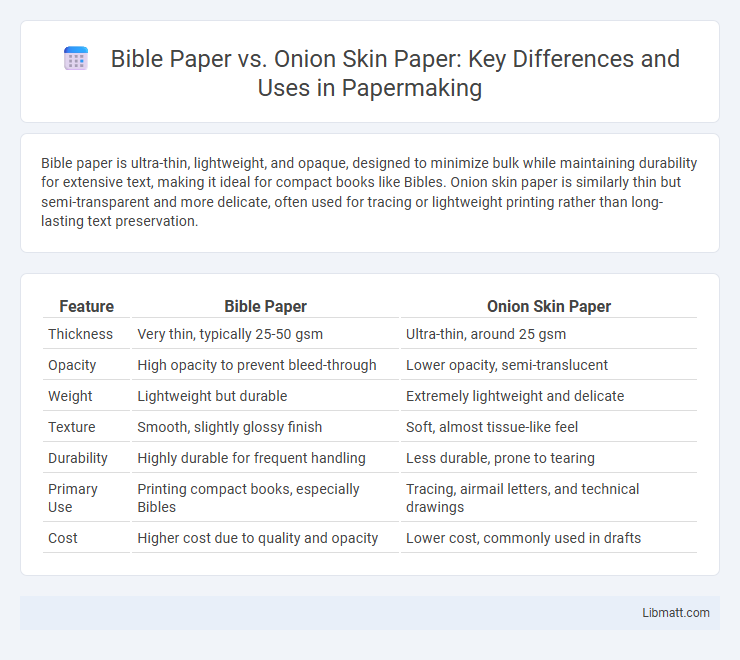Bible paper is ultra-thin, lightweight, and opaque, designed to minimize bulk while maintaining durability for extensive text, making it ideal for compact books like Bibles. Onion skin paper is similarly thin but semi-transparent and more delicate, often used for tracing or lightweight printing rather than long-lasting text preservation.
Table of Comparison
| Feature | Bible Paper | Onion Skin Paper |
|---|---|---|
| Thickness | Very thin, typically 25-50 gsm | Ultra-thin, around 25 gsm |
| Opacity | High opacity to prevent bleed-through | Lower opacity, semi-translucent |
| Weight | Lightweight but durable | Extremely lightweight and delicate |
| Texture | Smooth, slightly glossy finish | Soft, almost tissue-like feel |
| Durability | Highly durable for frequent handling | Less durable, prone to tearing |
| Primary Use | Printing compact books, especially Bibles | Tracing, airmail letters, and technical drawings |
| Cost | Higher cost due to quality and opacity | Lower cost, commonly used in drafts |
Introduction to Bible Paper and Onion Skin Paper
Bible paper is a thin, lightweight, and durable material primarily used for printing religious texts like Bibles, enabling thousands of pages to be packed into a compact volume. Onion skin paper, known for its translucent and lightweight nature, is often utilized for typewriting, airmail envelopes, and tracing. Your choice between these two depends on the need for opacity and thickness versus translucency and delicate texture.
Defining Bible Paper: Key Characteristics
Bible paper is a thin, lightweight, and durable paper specially designed for printing extensive texts like Bibles, allowing for compact volumes without excessive bulk. Its high opacity prevents text from showing through, enhancing readability despite the thinness, which contrasts with onion skin paper's delicate, translucent nature often used for tracing. Your choice between Bible paper and onion skin paper should consider the need for durability and opacity versus translucency and lightness.
Understanding Onion Skin Paper: Features and Uses
Onion skin paper is a lightweight, translucent paper known for its unique durability and smooth texture, often used for typewriting, drafting, and archival documents. Its thinness allows for easy layering and tracing, making it ideal for artistic and clerical purposes where precision and clarity are essential. Understanding these features helps you choose onion skin paper for specialized tasks requiring a balance of strength and delicate translucency.
Historical Background of Both Paper Types
Bible paper, traditionally known as India paper, originated in the 19th century to address the need for thin, lightweight paper enabling compact book printing, especially for Bibles and dictionaries. Onion skin paper, traceable to early 20th-century use, was developed for its translucent, durable qualities, often utilized in typewriting and carbon copies. Your choice between these papers reflects a balance of historic innovation in durability and thinness tailored to specific uses in documentation and printing.
Material Composition: What Are They Made Of?
Bible paper is crafted from a blend of wood pulp and cotton fibers, resulting in a thin, yet durable and opaque material designed to prevent bleed-through in printed texts. Onion skin paper, traditionally made from cotton or rag fibers, is exceptionally lightweight and translucent, offering a smooth surface ideal for writing or tracing. Your choice depends on whether you prioritize opacity and durability, as in Bible paper, or translucency and lightness, as found in onion skin paper.
Thickness and Weight Comparison
Bible paper is significantly thinner and lighter than onion skin paper, typically measuring around 0.04 mm in thickness and weighing approximately 30-40 gsm, designed to maximize page count while minimizing bulk. Onion skin paper is slightly thicker, with a thickness near 0.06 mm and a weight ranging from 40-55 gsm, offering more durability while remaining lightweight and translucent. Choosing between the two depends on your preference for extreme thinness and flexibility of Bible paper versus the slightly sturdier and more opaque texture of onion skin paper.
Durability and Longevity Analysis
Bible paper exhibits high durability with its unique blend of long fibers and strong pulp, making it resistant to wear and tear over extended periods. Onion skin paper, although lightweight and translucent, tends to be more fragile and prone to brittleness and tearing, reducing its longevity in comparison. Your choice for archival quality or frequent handling should favor Bible paper for superior strength and lasting preservation.
Applications in Publishing and Documentation
Bible paper is renowned for its ultra-thin yet durable quality, making it ideal for publishing compact books such as Bibles and dictionaries where conserving space is crucial. Onion skin paper, characterized by its lightweight and translucent properties, is primarily used in typewriting, airmail letters, and archival documents requiring easy handling and longevity. Choosing the right paper enhances Your document's readability, durability, and suitability for its intended publication or archival purpose.
Print Quality and Readability Differences
Bible paper offers superior print quality due to its smooth, ultra-thin texture that allows ink to adhere sharply and clearly, ensuring crisp readability even with tiny fonts. Onion skin paper, while lightweight and translucent, tends to produce slightly fuzzier print results because its fibrous surface absorbs ink unevenly, reducing overall clarity. If your priority is high readability and fine detail in printed text, Bible paper is the optimal choice for your project.
Environmental Impact and Sustainability
Bible paper uses wood pulp, which raises concerns about deforestation and long-term environmental impact, whereas onion skin paper often incorporates recycled fibers, enhancing its sustainability profile. You can reduce ecological footprints by choosing onion skin paper due to its lower resource consumption and potential for biodegradability. Sustainable paper options prioritize responsible sourcing, lower water use, and reduced chemical processing compared to traditional Bible paper production.
bible paper vs onion skin paper Infographic

 libmatt.com
libmatt.com